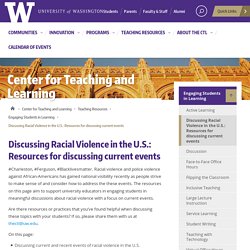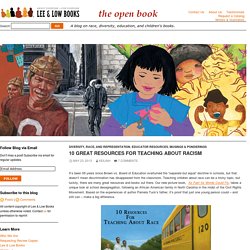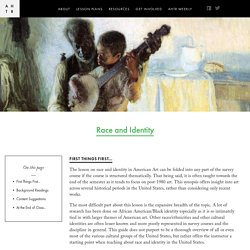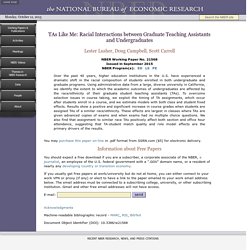

Resources for Talking to Kids About Race and Racism As Black History Month comes to a close, I thought I would share some resources for talking to kids about racism, in terms of both the historical context of our country and the present-day issues of prejudice.

I am a firm believer that we should be talking to our kids about racial differences from a very young age. At a certain age, all kids are prone to leaving others out based on external factors. This can be gender, race, disability, etc. I think kids need help to overcome this natural tendency to seek out "sameness. " I also think they need intentionality, especially when living in non-diverse areas. I don't know that there is a universal timeline that fits every child, because maturity levels vary. Close Amazon The Colors Of Us By Karen Katz The Skin You Live In, Written by Michael Tyler and Illustrated by David Lee Csicsko A Rainbow of Friends by P.K. Teaching about Race and Rights. Last month, 10th grade English teacher Arianna Talebian came up with the names of more than 80 people who died at the hands of police over the past 20 years.

She wrote the facts of their cases on index cards, which she and her co-teacher passed around to their students at Williamsburg Prep. The students’ discussion became so impassioned, she said the cards disappeared. “They had memorized, they knew the name, they knew the age, what state it was in and what happened in the aftermath that came from it,” she recalled. “They were angry, they were frustrated, they were asking where was the protest for this person? Where was the protest for that person?” Discussing Racial Violence in the U.S.: Resources for discussing current events. #Charleston, #Ferguson, #Blacklivesmatter.

Racial violence and police violence against African-Americans has gained national visibility recently as people strive to make sense of and consider how to address the these events. The resources on this page aim to support university educators in engaging students in meaningful discussions about racial violence with a focus on current events. Are there resources or practices that you’ve found helpful when discussing these topics with your students? If so, please share them with us at thectl@uw.edu. On this page: Tools for Teaching Diversity. Rossier Faculty Council’s Diversity Committee is charged with: supporting dialogue with faculty about issues of diversity and equity, and seeking faculty input about new and ongoing priorities; working with faculty search committees to help develop a diverse candidate pool; and assisting the dean’s office, faculty council, and concentration chairs in faculty mentoring.

Overview Welcome to the resources for teaching and learning diversity! This page was developed by the diversity committee of the Rossier School of Education in order to help faculty across all courses and in all programs better teach the concepts of diversity. 10 Great Resources for Teaching About Racism. It’s been 59 years since Brown vs.

Board of Education overturned the “separate but equal” doctrine in schools, but that doesn’t mean discrimination has disappeared from the classroom. Teaching children about race can be a tricky topic, but luckily, there are many great resources and books out there. Our new picture book, As Fast As Words Could Fly, takes a unique look at school desegregation, following an African American family in North Carolina in the midst of the Civil Rights Movement.
Based on the experiences of author Pamela Tuck’s father, it’s proof that just one young person could – and still can – make a big difference. Resources for Addressing Ferguson in the Classroom - Teaching Now. Race Matters in the Classroom. This blog started in response to the need for a forum on race and teaching theology and religion in the wake of the August 2014 shooting of Michael Brown and subsequent protests and police response in Ferguson, Missouri.

However, we have purposively framed the blog more broadly than this single incident. Diversity Toolkit: Race and Ethnicity. Found in: Teaching Strategies Teaching about race and racism in the United States is a complex and emotional process.

While many of us think of race as fixed categories - Asian, Black, and White, for example - many scholars have noted that race is not a biological category, but an idea, a social construction, that people use to interpret human differences and justify socioeconomic arrangements in ways that benefit one social group over another (Adams, Bell, Griffin 2007). RACE - The Power of an Illusion . For Teachers. Art History Teaching Resources. Images: Henry Ossawa Tanner, The Banjo Lesson, 1893William H.

West’s Minstrel Show, 1900, LithographLois Maillou Jones, The Ascent of Ethiopia, 1932Romare Bearden, Jammin’ at the Savoy, n.d.Faith Ringgold, Who’s Afraid of Aunt Jemima, 1983Bruce Davidson, Time of Change (the Rev. Ralph Abernathy, Ralph Bunche, Martin Luther King Jr., Mrs. TAs Like Me: Racial Interactions between Graduate Teaching Assistants and Undergraduates. NBER Working Paper No. 21568Issued in September 2015NBER Program(s): ED LS PE Over the past 40 years, higher education institutions in the U.S. have experienced a dramatic shift in the racial composition of students enrolled in both undergraduate and graduate programs.

Using administrative data from a large, diverse university in California, we identify the extent to which the academic outcomes of undergraduates are affected by the race/ethnicity of their graduate student teaching assistants (TAs). The Pedagogy of Teaching Race. Adult Learningalx.sagepub.com Adult Learning May 9, 2014 1045159514534392 The first page of the PDF of this article appears below.

Click image below to view at full size. Teaching Race Across the Curriculum to the Millennial Generation by Leonard M. Baynes. St. John's University - School of LawMay 16, 2012 St. John's Legal Studies Research Paper No. 12-0011 Abstract: In this article, Professor Baynes shares his insights on how to teach racial and social justice issues in the basic business organizations course. The Use of Social Media in Teaching Race. Abstract This article explores ways in which race pedagogy interrogates social media as a significant influence on racism and source for race understandings.
Social media serves as a context in which to learn about, challenge, and address issues of race. We discuss how social media may be used to promote racial literacy and question and resist racism, using a YouTube post example, comment stream, and video responses. Our focus includes a discussion of intersectionality and highlights ways in which resisting racism may still involve sexism or other oppression. Article Notes Conflict of Interest The author(s) declared no potential conflicts of interest with respect to the authorship and/or publication of this article.
How the #FergusonSyllabus Can Help Teachers Talk About Race and Rights on the First Day of School by Liz Pleasant. With the first day of school just around the corner, teachers across the country are wondering how to incorporate discussions of the violent clashes between the Ferguson, Mo., police department and protesters in the weeks after the killing of unarmed 18-year old Michael Brown.
How to Teach Kids about Race . Expert Q&A . PBS Parents. Home » Archives » by Madeleine Rogin Sorry, Madeleine Rogin is no longer taking questions. For years I attempted to teach about Martin Luther King Jr. to my five- and six-year-old Kindergarten students without talking about racism. There were many reasons for this. I had fears and insecurities about how to talk about racism with young children.
So each year when it came time to celebrate Dr. Teaching tolerance: How white parents should talk to their kids about race. Photo by Purestock/Thinkstock Last summer, my family moved from Brooklyn to a small town in the Hudson Valley. We love our new life, but one thing about the community is not so great: It’s predominantly white. What will it mean in the long run if my white children don’t see and befriend people who come from different racial backgrounds? And are there steps I can take to instill racial sensitivity and acceptance in my kids despite the fact that they’re growing up in an ethnic bubble?
To find out, I dug into research on the causes of racial bias and talked to developmental and social psychologists, race-relations researchers, and Africologists. Teaching Race and Ethnic Relations. Teaching about Race and Ethnicity. Talking About Race and Racism in the Classroom. Download the pdf version. Teaching Teachers to Reflect on Race. By Tyrone Howard. Teaching Young Children about Race. Framingham, MA Guide to Teaching Race Unit. Teaching about Race. Teaching Race in Schools in the 21st Century. <-- Return to Classroom Index. Teaching about Race: 101. You are now a census taker. Below are photos of people born before 1930. Using U.S. census categories for "race" that were available at that time, please select the race of each person.
You may select from the following categories. Talking About Race and Racism. Essential Question What do I need to participate in an open and honest conversation about the content of The New Jim Crow? Uncomfortable Conversations: Talking About Race In The Classroom : NPR Ed. Open up the newspaper or turn on the news these days, and you'll find plenty of talk about race and racism. But it's a different story in many classrooms. Some teachers don't consider race germane to their math or English syllabus.
Others strive for colorblindness in the classroom, wanting to believe we live in a post-racial society. Resources - For Teachers.